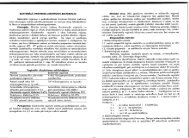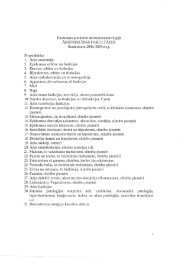PHYSICS
n - susliks.lv
n - susliks.lv
- No tags were found...
Create successful ePaper yourself
Turn your PDF publications into a flip-book with our unique Google optimized e-Paper software.
Thermal expansion: the extreme heat<br />
of a July day in Asbury Park,<br />
New Jersey, USA, caused these<br />
railroad tracks to buckle<br />
(Wide World Photos)<br />
the initial and final equilibrium states (that is, for various processes),<br />
one can find that Q A is the same for all paths connecting<br />
the initial and final states. We conclude that the quantity<br />
Q - A is determined completely by the initial and final states of<br />
the system, and we call the quantity change in (Q -<br />
A) the<br />
internal energy of the system, which is independent of the path.<br />
The internal energy function is U and changes in the internal<br />
energy can be expressed as:<br />
t1U = U, U; = Q - A (12.4)<br />
where all quantities must have the same energy units. This<br />
equation is known as the first law of thermodynamics.<br />
12.4. THERMODYNAMIC SYSTEMS<br />
A thermodynamic system is that part of the universe that is<br />
under consideration. A real or imaginary boundary separates the<br />
system from the rest of the universe, which is referred to as the<br />
surroundings.<br />
Thermodynamic systems are classified into three categories:<br />
• Isolated systems do not exchange energy or matter with the<br />
exterior;<br />
• Closed systems exchange energy with the exterior but not<br />
matter;<br />
• Open systems exchange both energy and matter with the<br />
exterior.<br />
When a system is at equilibrium under a given set of conditions,<br />
it is said to be in a definite thermodynamic state.<br />
12.5. THE FIRST LAW OF THERMODYNAMICS<br />
The first law of thermodynamics is a generalization of the law<br />
of conservation of energy and includes possible changes in<br />
internal energy.<br />
Suppose a thermodynamic system undergoes a change from an<br />
initial state to a final state in which Q units of heat are absorbed<br />
(or removed) and A is the work done by (or on) the system. If<br />
the quantity (Q - A) is measured for various paths connecting<br />
90<br />
. 12.6. THE SECOND LAW OF THERMODYNAMICS<br />
The second law of thermodynamics establishes which processes<br />
in nature mayor may not occur. The field of thermodynamics<br />
evolved from a study of heat engine - a device that converts<br />
thermal energy into other useful forms of energy, such as<br />
mechanical and electrical energy. It is useful to represent a heat<br />
engine schematically as in fig. 12.2. The engine (represented by the<br />
circle at the center of the diagram) absorbs a quantity of heat<br />
(Q,,) from the high-temperature reservoir. It does work (A) and<br />
gives up heat (Q) to a lower-temperature heat reservoir. The net<br />
work (A) done by the engine equals the net heat flowing into the<br />
engine:<br />
A = Q -<br />
(12.5)<br />
h<br />
The thermal efficiency (17) of a heat engine is defined as the<br />
.... , ---~I ratio of the net work done to the heat absorbed<br />
during one cycle:<br />
Heat engine<br />
Q c<br />
1] =~=Q,,-Qc =l-~<br />
Q" Q" Q"<br />
(12.6)<br />
Fig. 12.2. Schematic representation of a heat engine<br />
that receives heat Q] from a hot reservoir, expels<br />
heat Q 2<br />
to the cold reservoir, and does work A<br />
91






